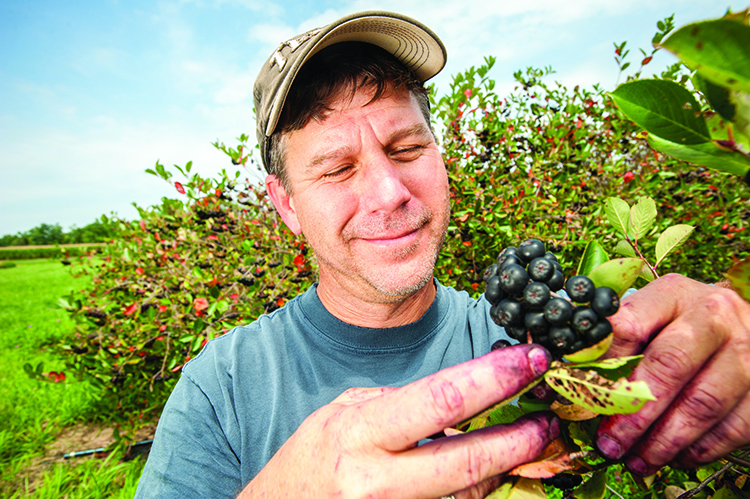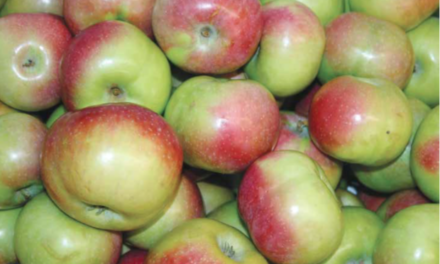
With higher amounts of antioxidants than blueberries, locally-grown aronia also surpasses widely touted tropically sourced acai, whose shipping and processing diminishes it’s beneficial properties, notes Andrew Ristvey, commercial horticulture Extension specialist at Wye Research & Education Center in Queenstown. (Photo by Edwin Remsberg)
If you could choose any fruit tree to grow, which would you pick?.
Today’s iconic standby, the apple, would likely be the most popular answer.
But some area growers with a taste for adventure are branching out, helping to carve a new niche for forgotten native varieties, among them aronia, beach plum, and paw paw.
Aronia
Molly and Roy Mears, owners of Chester River Aronia in Kent County, joined the enterprising aronia pioneers’ ranks several years ago.
To keep their grandparents’ farmstead they grew up on going, Molly and her four siblings sought guidance from Andrew G. Ristvey, Commercial Horticulture Extension Specialist at Wye Research & Education Center, Queenstown.
He introduced them to the tart-tasting aronia, which resembles a rustic blueberry, also known as black chokeberry.
However, aronia is not a berry, but a pome fruit like apples and pears, and member of the rose family, according to Ristvey.
In 2011 the family planted 370 seedlings. Over the years, several siblings passed away, others stepped aside, and in 2020 Roy and Molly became official sole operators of Chester River Aronia.
The Mears are regular vendors at the Kent Island and Chestertown Farmers Markets, selling jam, jelly, bread, and vinegar.
Their products have attracted a dedicated and growing clientele, many of whom have offered testimonials lauding numerous health benefits experienced, despite most locals still unaware of aronia.
With higher amounts of antioxidants than blueberries, locally-grown aronia also surpasses widely touted tropically sourced acai, whose shipping and processing diminishes it’s beneficial properties, Ristvey noted.
“When we visit shows around Maryland, it always amazes me how out of a hundred people I talk to, maybe one has heard of it,” he added.
An exception was one family with Eastern European roots, who excitedly recognized Aronia because they’d grown up with it.
Russian horticulturist Ivan Michurin encountered the plant during a Mid-Atlantic visit in the late 1800s and became intrigued by Native American accolades.
After bringing it back with him, aronia eventually became widely grown and used to make jelly and wine. It also became a food and textile coloring agent, Ristvey mentioned.
UMES Chemistry Professor Victoria Volkis, currently collaborating with Ristvey on an Aronia teaching project, recalled Aronia trees growing at her father’s dacha (home) in Russia.
Although Roy Mears enjoys the fruit’s tanginess, he admits that the tannin-packed skin, though highly nutritious, tastes very bitter.
The hydraulic press he crafted for Molly’s Jelly, including a seedless variety for folks suffering from diverticulitis, leaves a residue of surplus skins, but they don’t go to waste; Roy adds them to smoothies.
A nearby herbal enterprise has also expressed interest in the skins for making tea and vinegar.
Family and friends help handpick the fruit just after the 4th of July, with customers who come out to pick their own getting a discount.
The tough woody stems are “pretty user friendly, there are no thorns” and the fruit isn’t overly fragile,” Roy added. “It comes off in clumps, so they fill up a basket fairly quickly.”
Ristvey has several recommendations for home gardeners, including planting in a spot receiving 8 hours of solid sunlight to ensure flowering.
Also, add a quarter-ounce of nitrogen when planting and apply 2 inches of good compost to help establish hardy prolific producers.
“With 10 trees growers can probably get up to 40 pounds of fruit,” Ristvey mentioned. But just one of his test area trees has produced 20 to 30 pounds of fruit alone.
Planting native aronia trees also helps supply much-needed pollen to the habitat of struggling native bees, which are aronia’s chief pollinating partner, he commented.
Beach Plum
Dr. Richard Uva of Seaberry Farm in Federalsburg grew up on Cape Cod, home turf to a tenacious stone fruit known for growing wild amidst beach dunes, the humble but hardy beach plum. Not widely known outside its central growing region, the fruit claims legions of faithful fans who have traditionally traipsed the sand fantastic in pursuit of the fruit, plus generations of devotees of its delectable edible concoctions.
Beach Plum became a focus of Uva’s academic career, first as the topic of his doctoral dissertation at Cornell, then as manager of the University Horticulture Department’s beach plum agricultural sustainability project.
In 2003 his paper, Tracking The Wild Beach Plum, published in Harvard’s Arnoldia Arboretum journal, traced the long history of Prunus maritima, and recounted his longstanding relationship with it:
“I was fascinated by this long-lived species ability to thrive in environments with salt, apparent drought, and frequent disturbance,” Uva wrote, noting that even its hardiest botanic neighbors were “often short-lived.”
Native Americans and early settlers partook of the wild, “cherry-sized plums” whose flavor ranges from “astringent to relatively sweet when ripe.” While “rarely eaten raw,” its unique twang brings a prized flavor to jelly, whose production remains a much-honored “cultural tradition” in coastal communities throughout its range, from Maine down to Delaware.
“It’s still plentiful in Lewes and Rehoboth Beach,” Uva noted. (Considering the possibility of finding beach plum in Assateague, he admitted to not having any reliable information, jokingly suggesting that the ponies may have eaten them already.”
About 14 years ago, Uva and his wife Wenfei, a fellow Cornell horticulture specialist, moved their family to Federalsburg and started Seaberry Farm. Intended as a commercial venture, the farm also provided an enriching opportunity to experiment with growing speciality fruits and flowers, among them, Rick’s beloved beach plum.
Bolstered by Wenfei’s design and marketing expertise, Seaberry Farm’s floral business flourished and became the couple’s prime focus. But Rick still grows several stands of beach plum (and paw paw), selling the fruit to Delaware producers including Backyard Jams and Jellies in Milton and Beach Time Distilling in Lewes (for gin and rum).
Over the years, he’s managed to cultivate several rows from trees he’s personally grafted for more consistent domesticated production.
“In the wild, beach plum doesn’t yield fruit each year,” he noted. To keep his trees from going “all-out one year with nothing the next,” Uva carefully maintains a pruning regimen designed to help it produce each year. The main disease issue he’s coped with has been some brown rot, similar to that found on peach trees, he added.
Paw Paw
While beach plum needs sun, “paw paw can take a little shade,” Uva advised. That makes sense, as paw paw is commonly found growing wild as a forest understory plant.
Food historians believe the paw paw found its way to North America through the digestive track of roaming Mastodons. Indigenous Americans valued its creamy, custard-like flavor (often described as a cross between banana and mango), gathering and possibly cultivating it. Early American settlers and colonists also partook of paw paw’s delights. Explorers Lewis and Clark credited the fruit with saving them during a food shortage on their journey and Washington and Jefferson’s growers planted it at Mount Vernon and Monticello.
Distance shipping, while a boon to many fruits, became a disadvantage to the paw paw, due to a relatively brief freshness window and tender skin that is easily bruised.
On the Western Shore, Jim Davis was among the first nationally to commercially grow paw paw and today is one of the largest. Since the 1990s he’s dedicated six of his 41 Deep Run Farm acres in Westminster, Md., to a 1,000 paw paw tree orchard.
It’s taken “a lot of trial and error,” he said, but his orchard is flourishing, thanks to a gradual but steadily growing awareness he’s noted year by year and believes is continuing to “gather steam.”
“Most people don’t even know what a paw paw is, I’d say that probably 90 to 95 percent of people in North America haven’t heard of it,” Davis noted. “As more people find out about what they can do with paw paw, the interest grows.”
Currently, Davis partners with Checkerspot and Baltimore County Brewing plus others in Pennsylvania and Virginia.
He also supplies paw paws to a variety of chefs, among them Baltimore Country Club Executive Chef Richard Jallet.
Davis also regularly fields a growing number of inquiries from home gardeners interested in learning where to acquire the “beautiful looking, very ornamental” trees.
Among his own mentors is West Virginian Neal Peterson (https://www.petersonpawpaws.com/) and edible landscaping guru Michael Judd of Frederick Maryland.
This fall, Judd will sponsor his 6th annual Paw Paw festival in Frederick. He literally “wrote the book” on paw paw growing, entitled “For the Love of Paw Paws, A Mini-Manual For Growing and Caring for Paw Paws from Seed to Table” (ecologia, 2019).
For more information on growing these and other forgotten fruits: Visit https://www.chesterriveraronia.com/, https://seaberryfarm.com/, and https://marylandsbest.maryland.gov/producer/deep-run-pawpaw-orchard-inc/




